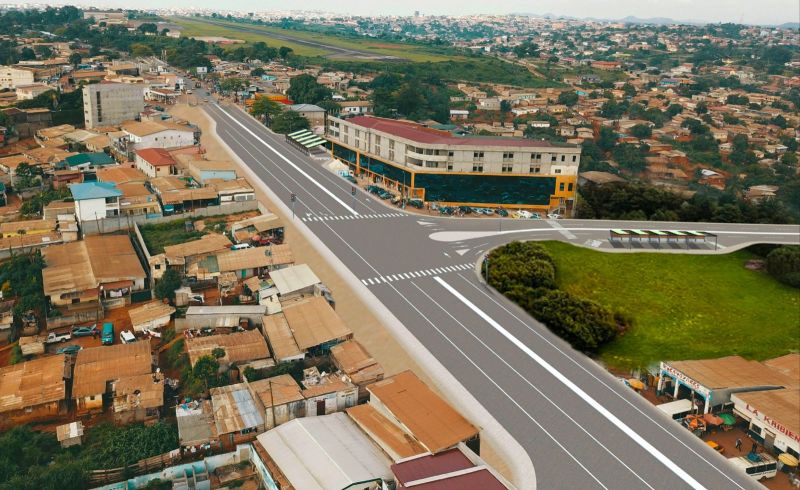Cameroon Urban Investment Defies Election Volatility
Cameroon’s Coeur de Ville codifies capex continuity as EMB gauges frontier credit appetite and AFK tracks Africa equity flows, while XAF=X and oil benchmarks CL=F and BZ=F shape imported input costs and funding spreads into 2027.

Cameroon’s decision to keep Yaoundé’s “Cœur de Ville” urban renewal on track beyond the 2025 elections is a deliberate attempt to detach capital formation from political turnover and to signal execution credibility to lenders. The program targets central transport links, public spaces, and commercial corridors that constrain productivity in a capital where services account for roughly half of output.
With real GDP growth projected around 3.6–3.9% in 2025 and public and publicly guaranteed debt near the high-40s percent of GDP at end-2024, the authorities are prioritizing predictable disbursements over pre-election discretion. In a CEMAC context of easing inflation toward 2.6% in 2025 and a BEAC policy corridor set at 3.25%–5.25%, the state cannot rely on cheaper credit to mask project risk; governance, phasing, and cash-flow visibility must carry the adjustment.
The continuity mechanism is designed to compress the policy-uncertainty discount embedded in frontier urban infrastructure. By locking in financing tranches, compensation schedules, and phased works before the vote, municipal managers aim to neutralize the post-election hiatus that typically drives under-execution and cost overruns. Because imported inputs and equipment are USD-linked, currency stability versus the dollar (XAF=X) remains a binding constraint on capex; disciplined procurement and milestone-based payments reduce exposure to adverse FX moves and contractor opportunism. A credible pipeline with quarterly milestones narrows payoff dispersion for contractors, financiers, and property developers and raises the odds that private co-funding can be mobilized at tolerable spreads.
The macro and sector channels are quantifiable. Urban logistics frictions inflate business operating costs by double digits across African capitals; targeted upgrades can lift city-level productivity by about 1 percentage point annually and expand the property-tax base by 0.2–0.4% of GDP as formal activity densifies. Stabilizing capex through 2027 supports a growth mix less reliant on hydrocarbons and imported energy, limiting external-balance sensitivity to global oil benchmarks such as Brent and WTI (BZ=F, CL=F). If execution remains steady while inflation trends lower, Cameroon’s local nominal yields at regional auctions should stabilize in the mid- to high-single digits, improving duration access for sub-sovereign structures without inflating contingent liabilities.
Markets will parse the signal through both hard-currency and regional proxies. Frontier risk appetite is tracked via EM hard-currency debt and Africa equity baskets (EMB, AFK). Sustained execution, transparent procurement, and clean compensation processes argue for modest spread compression versus EM beta; slippage—under-execution above 10%, arrears to contractors, or opaque change orders—would widen the differential and reprice Cameroon alongside weaker peers. Currency risk is secondary for local-currency civil works, but USD exposure for imported materials and equipment remains non-trivial; a firmer dollar would lift project costs and offset some gains from better governance, especially if shipping rates or commodity inputs rise concurrently.
Comparatives across the region support the approach. Cities that ring-fence operations and maintenance cash flows, publish dashboards on disbursements and milestones, and tie capex draws to measurable reductions in bottlenecks tend to crowd in private lenders and extend tenors. Sequencing matters: escrowing billed municipal revenues, prioritizing utility inputs, enforcing milestone-based contractor payments, and standardizing right-of-way compensation turn political commitment into a financial asset—lower variance around completion, fewer fiscal surprises for bondholders, and a clearer path to PPP participation. This is how continuity moves from rhetoric to priced credibility.
The forward test is explicit and time-bound. By end-2027, three indicators should determine whether the continuity pledge translates into institutional strength: disbursement rates above 90% across two consecutive post-election budgets; under-execution contained below 10% with cost overruns capped under 15%; and private or donor co-financing contributing at least 30% of phase funding.
If these conditions are met while inflation converges toward the 3% region and local auction yields hold in the 7–9% range, Cameroon’s infrastructure risk premium should tighten toward EM comparables, enabling cheaper refinancing and deeper PPP markets. Miss those thresholds—particularly if XAF=X weakens alongside higher oil benchmarks (CL=F, BZ=F)—and the market will reprice quickly, raising funding costs, stretching timelines, and diluting the institutional signal that the announcement is intended to send.





